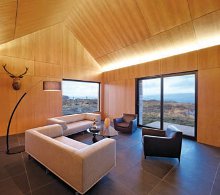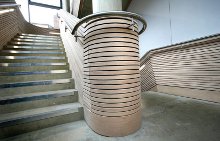Fire focus cools
21 September 2013Builders are increasingly turning to site safety to reduce the risk of a fire. Robin Meade reports.
Urgent efforts to safeguard timber frame construction sites put fire retardants (FR) into the spotlight, but some manufacturers and timber treaters now say it failed to generate the level of sales they had anticipated. Other measures in a package hammered out to deal with the threat appear to have made a fuller contribution and the UK Timber Frame Association (UKTFA) has confirmed it has stood down its fire committee.
The UKTFA, which is to relaunch as the Structural Timber Association at Timber Expo next week, headed the work to tackle the catalogue of catastrophic fires that threatened to cripple the timber industry's work to showcase wood as a desirable construction material.
A report by the Department for Communities & Local Government states there were 118 fires in timber-framed buildings under construction in the three years to last year compared with 1,103 in buildings whose structure was of no special construction, a ratio of 1:9. The UKTFA's Site Safe Fire Risk Management programme, which included a list of approved products and systems, was finalised last year and endorsed by the Health & Safety Executive (HSE).
Gordon Ewbank, commercial director at Osmose Europe, said Crown Timber, which applies Protim Frameguard, had seen some reasonable sales volumes. But he added: "That market has not shown the sales that we expected. It was only ever going to be applicable to higher rise and big projects, and there has been less of that in the recession anyway.
"The other things we are finding in practice is that there has been a real growth in noncombustible sheathing and closed panel systems and also, rather than using FR throughout the project, they have concentrated on the boundary of the site. The feedback we are getting is that fire is no longer the issue and not a barrier to using timber frame."
Richard Gulland, head of technical sales for BASF Wolman in the UK and Ireland, said UKTFA's guidance on measures such as separating distances, wireless fire alarms and perimeter fencing had worked well.
"It's all very sensible, but the window is four to five weeks and contractors have just increased security. Also, fire retardant just suppresses the fire, it does not stop it, you still have to replace the wood, so you can see why they have gone down the route they have," he said.
UKTFA chief executive Andrew Carpenter said that as a one-off topic fire was not a priority any more. "We are standing down our fire committee and this will return to be part of the technical committee. The powers that be (HSE, insurance companies and chief fire officers) have accepted what we have done in the past couple of years. We can now take the emphasis off fire and put it back as a technical issue," he said.
SiteSafe solutions
"SiteSafe is working. As a trade association what we are looking for is to provide solutions; we would not favour one form of protection over others and let the client choose whichever solution is right for them. There is clearly a move toward more closed panel timber frame, not just because of fire safety but it is to do with being airtight, improved U-values, all those kinds of things. Again, that's their decision."
Hull-based WJ Components is considering adding a tank for Wolman FR in its recently opened operation at the Scotline Terminal in Rochester. But director Mark Eggleston has his eyes more on the massive Crossrail project as demand for timber frame had not been as high as he expected and, although the Wolman FireStop was an approved product, he had not yet sought accreditation.
"I got quite involved to try and sort things out, but it is not a standard as such, it's not like gaining Euro Class B or C in fire retardancy. FR Build does not specify a standard; it's testing to see if it passes or fails. I think it is too complicated," he said.
About 50% of the FR market is projectspecific, although there is always business in scaffold boards, shingles and exhibition materials. "The majority of FR goes into major projects such as schools, libraries etc. There has been a downturn in these areas because of the recession, but there has been a little bit of an uplift recently," said Mr Ewbank.
Crossrail is good business for Osmose and treater PTG has been well placed in Tilbury to supply the project. Lonza Wood Protection carries out FR treatments at its own treatment centre at Castleford, accredited to ISO 9001 and ISO 14001. The company's FR treatment is used by Intelligent Wood Systems, which was the first to be accredited by the UKTFA. The company has also had particular success in major school projects.
"Treatment companies need to be quality accredited and have independent Classification Reports for their treatments for relevant timber species and timber thicknesses to ensure a reliable and relevant fire treatment," said a spokesperson. "Both our Dricon and Non-Com Exterior fire retardant treatments hold unique independent performance accreditations that ensure a tried, tested and trusted fire protection for timber in construction projects."

